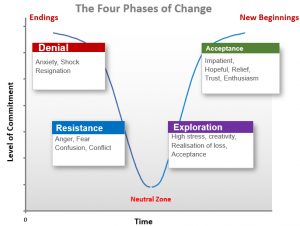Managing Through Change to Support a Positive Outcome
Understanding the internal, personal journey that we experience during change provides the Leader with an invaluable skill set to manage change effectively. The Change Curve models this journey of change. The four stages of change are presented here, with examples of both recognising the phases and advise on how to support firstly ourselves and then others through the process of change.

What is The Change Curve?
Consider any change you have experienced in your life; change of job, moving house, building your first home. Describe all the emotions that you experienced. Did your answer include any of the following?
Fear, Happy, Angry, Skeptical, Asking questions, Who is to blame, Frustrated, Elated, Questing, Not thinking about it, Isn’t happening, Interesting, I wonder what we could do differently, Excited.
These are the natural emotions we all work through when managing through a change. In the 1960’s, Swiss-American psychiatrist, Elisabeth Kubler-Ross, modeled the journey of change which is now known as The Change Model. It is a model that supports leaders and coaches manage change at a personal level, to support a smooth transition from resistance to acceptance. The four phases of change are:
Denial When a change is first introduced into our life, we may not want to consider the change or even acknowledge it exists. This can include feelings of shock or numbness and sometimes we carry on as normal.
Resistance As the change becomes real at a personal level, many strong emotions can be exhibited including anger, fear and in particular, blaming others. This is a journey of realising a loss has occurred and is real. Our level of commitment, either to the organisation or to others around them, will reduce significantly in this phase.
Exploration When self-doubt and self-questioning occurs, this is typically the tipping point on the change curve in terms, from resistance to beginning to accept change of level of commitment. This may present as looking to make improvements, address problems and moves into positive actions and constructive questions.
Acceptance: The change is now more palatable and you accept the change. You will feel better and project a positive approach towards the change and if fully accepted, embrace and be an advocate of change.
What Can you Do to Support the Change?
1. Support yourself first through the Change Curve
If you are part of the Change process, you will most likely be ahead of others on the journey of change. The first critical step is to understand where you yourself are on the change curve. This self-awareness will not only help manage yourself through the change, but will also help you understand how your emotions will impact others on the change journey. For example, if you are in the resistance phase and you are not self aware, consider the impact of your emotions will have on others, who may only be in the Denial phase. Self awareness is key on any change journey. Be emphatic towards yourself on the change journey also.

2. Supporting Others
Plan the change: Recognise that change happens at a personal level and that we are all in different places along the change curve. Map where everyone is on the change curve and manage appropriately throughout the change journey.

Start of Change: Communicate the facts, both accurate facts and in a timely manner, and the impact on the facts, both for the organisation and in particular for the individual. Recognise in the communication that this is a change.
Denial Phase: This will happen when the change is first communicated. Recognise in your two-way conversations that a change has happen, repeat the facts, listen to what the person has to say.  You may have to repeat the facts, repeatedly, so be patient and genuine, with this repeated communication.
You may have to repeat the facts, repeatedly, so be patient and genuine, with this repeated communication.

Resistance Phase: Listen. Do not engage with logic at this point until the person is calmer. When person is calmer, engage in 2 way conversation and actively listen to the concerns. Ideally coach the person through this part of the change. Patience is critical here as opposed to problem solving.
Exploration: Communicate. Answer all questions raised and be prepared to have answers of the impact the change will have to the individual and potential benefits of the change to the individual. Be available to answer questions. This tipping point is critical and coaching people to remain part of the solution here supports the personal moving through the exploration stage, rather than return to the resistance phase (this will also happen, so monitor closely)
Acceptance: The individual has now accepted the loss of the old practice and embraced the change, in a level that suits the person. Continue to communicate facts to the individual, involve them in the management of new processes and encourage lessons learned.

For more information on how to Manage Change please contact Clodagh




